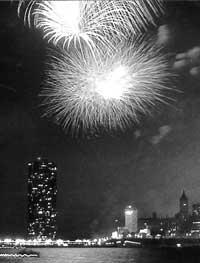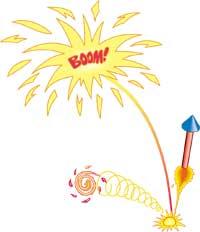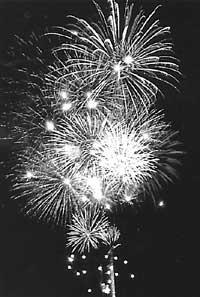Fireworks
1997/07/01 Irureta Azkune, Onintza Iturria: Elhuyar aldizkaria

Fireworks staff make a lot of rockets available at night. The spectator just has to look up and see how the rockets explode and how not, enjoy color and light. But how do the rockets reach the sky and how do these colorful stars appear in the sky?
Gunpowder is the key
Black powder is the fuel of fireworks or fireworks. Before explaining how fireworks work work, let's review the details of gunpowder.
The name of the gunpowder inventor is unknown and neither is it known when and where it was first used. The first fingerprint of gunpowder users was found in China and it is possible that this fuel was invented in the large Asian country. XI. In the 19th century, almost a thousand years ago, the Chinese used gunpowder as fuel for common rockets, explosive fuel. The rockets became communication channels, as the noise heard could put Chinese away from each other. Communication difficulties caused by remoteness were overcome by rockets and several lives were saved by the noise of the gunpowder explosion. Mail rockets also appeared over time.

To know what gunpowder was in the West, the presence of Chinese rockets was not necessary. The XII mixture of fire, burning smell and noise was brought by the Arabs. In the 20th century towards Europe. However, gunpowder has not only been rocket fuel. Black gunpowder is an explosive fuel that, in addition to generating colorful images in the dark, has been used in numerous wars as a firearm fuel. The Arabs first came up with the use of black gunpowder in weapons and the XV. In the 19th century, in western Europe, explosive fuel was used in almost all firearms of the time. The bombings, cannons and culebrines were part of the first artillery of European ships and armies and all these firearms were fueled by black gunpowder.
Black gunpowder in firearms XIX. It was used until the middle of the century. In the last two centuries, as in all other areas, the arms industry has experienced technological advances and black gunpowder has been widely discarded for weapons. However, black gunpowder rockets are still used to illuminate the war zone or signal at night, and especially to make missiles.
Now, in the absence of war, black gunpowder is used to be able to see colorful lights and multiple shapes in the night darkness.
Illuminating the gloom
We've had the word powder in our mouth and it's time to know why we see fireworks in the sky thanks to that gunpowder.

The main component of the fireworks launch rocket is black gunpowder or propelled gunpowder. The explosive dust consists of three elements: 75% potassium nitrate, 15% carbon and 10% sulfur. When the rocket is lit and the wick is lit, these three elements, the gunpowder, are burned. In addition, gunpowder burns on the viguilla. Gunpowder is an explosive fuel that exploits the rocket.
As a result, smoke and hot gases leave below the rocket, which pushes the rocket upwards. This ascent reaction is called propulsion. In the air the ignition of explosive matter occurs, that is, the burnt fuel, the powder, emits light for several seconds before the fuel is completely burned and the light leaves way to the gloom.
The process for fireworks to properly explode in the air starts down, on the ground. If you've ever seen the fireworks as they prepare the fires for the night, you've noticed that it's not a joke job to organize a lot of rockets. Each rocket is usually tied to a rod so that the rocket remains standing while the wick burns. If they were not held firmly with the rod, they would lose direction once they get into the air and could explode in an unnecessary place. All the rockets line each other and the fireworks experts, in a certain order and with all the attention in their work, give them fire to air.
- Fireworks colors: when metal salts are burned (strontium nitrate, copper oxychloride, etc.) evaporates and in that evaporation waves of different length occur: the colors we see.
- Rocket categories: in fireworks we can see different colors and shapes. To achieve this diversity, powder must be divided into different levels in each rocket. In progressive rockets it is usually a special wick that goes inside. Once the wick is burned, first explode a category powder. Then the seconds, etc. Thanks to this unique wick, the steps break one by one and each offers us fireworks of different colors and shapes.
- Final palm: many artificial fire sessions end with the launch of a palm tree and a large palm tree. Special rockets are needed to obtain this palm: ground aluminium and oxidizer are the components of the rocket that explode violently. After the explosion the rocket releases white light forming a palm tree with branches and white leaves.

Gai honi buruzko eduki gehiago
Elhuyarrek garatutako teknologia



